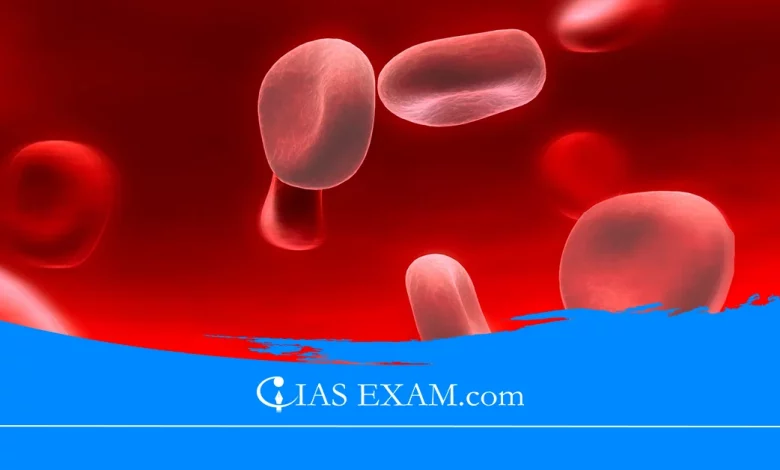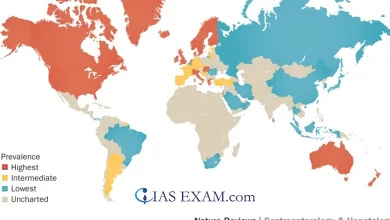Daily Current Affairs for UPSC
Anaemia Prevalence Overestimated in Eight States
Syllabus: Science and Technology [GS Paper-3]

Context
A recent study conducted in eight Indian States, with a total of 4,613 participants from different age groups, has discovered that previous surveys have overestimated the prevalence of anaemia.
Key Points
- The study, conducted across eight Indian states, involved 4,613 participants, including adolescents, adults, and the elderly.
- Assam has highest anaemia prevalence (69%), affecting 78.3% of women.
- Meghalaya has the lowest prevalence (12.1%), affecting 14.6% of women.
Details about the study
-
- The current study looked at venous blood given to measure haemoglobin levels and iron levels and compared with studies that have used finger prick-based capillary blood.
- Evaluation of capillary blood which causes a decreasing of haemoglobin level due to plasma-skimming dilution and the addition of tissue fluid mixing.
- In its latest guidelines, the World Health Organization complexifies the diagnosis of anaemia with blood samples collected by venipuncture and haemoglobin estimations.
- Report’s discovery pointed to the fact that most of the anaemia cases were mild, with the disparity between women and men in this anaemic occurrence being higher.
- The different age groups have shown distinct rates of anaemia, the anaemia is higher in the adolescent girls, women during adulthood, and the elderly men.
- According to the survey, the level of anaemia was low, as compared by the same studies that took plasma blood samples.
- Data categorised by states:This research claims that Assam has the highest rate of anaemia, of which 69.8% are affected overall and 78.3% women being affected especially.
-
- After Maharashtra, Odisha holds the 2nd position, with a demonstration rate of 55 percent across population and 63 percent in women.
- While contrarily, Meghalaya has the least anaemia prevalence altogether and among women, which is at 12.1% and 14.6% respectively.
- Telangana is just behind with women marking 16.9% and overall 24.6%.
- Next to them, states also faced with anaemia at relatively higher rates are West Bengal, Tamil Nadu, Gujarat, and Madhya Pradesh.
About Anaemia
- Anaemia is the name given to a disease in which there is a reduction in the number of red blood cells (RBCs), or the haemoglobin concentration (the protein that carries oxygen within the RBCs), is abnormal.
- Anaemia may have destructive consequences on general health and quality of living, being red blood cells the building blocks for the transportation of oxygen in the whole body. Early diagnosis and appropriate treatment should be considered as major factors in management of anaemia so as to avert the possible adverse outcomes.
- Causes: Anaemia can be caused by various factors, including:
- Blood loss (due to injury, heavy menstrual periods, or internal bleeding)
- Nutritional deficiencies (iron, vitamin B12, folate)
- Chronic diseases (kidney disease, cancer, inflammatory conditions)
- Inherited disorders (sickle cell anaemia, thalassemia)
- Bone marrow disorders or failure
- Types: The main types of anaemia are:
- Iron deficiency anaemia (the most common type)
- Vitamin deficiency anaemia (lack of vitamin B12 or folate)
- Anaemia of chronic disease
- Aplastic anaemia
- Haemolytic anaemia
- Symptoms: Depending on the severity, symptoms of anaemia may include fatigue, weakness, pale skin, shortness of breath, dizziness, headaches, and irregular heartbeats.
- Diagnosis: Anaemia is detected mainly by a full blood count test (CBC) that determines the number of red blood cells, the amount of haemoglobin, and other blood components.
- Treatment: The treatment of anaemia is very important on the identified cause. The options might include dietary changes, iron or vitamin supplements or medications, whereas in more serious cases, one would be treated with blood transfusion or bone marrow transplant.
Source: The Hindu
UPSC Mains Practice Question
Q.Discuss the implications of overestimating anaemia prevalence on public health policies, resource allocation, and interventions aimed at addressing the issue in these states. Analyse the potential reasons that might have led to the overestimation of anaemia prevalence in these states.





.png)



